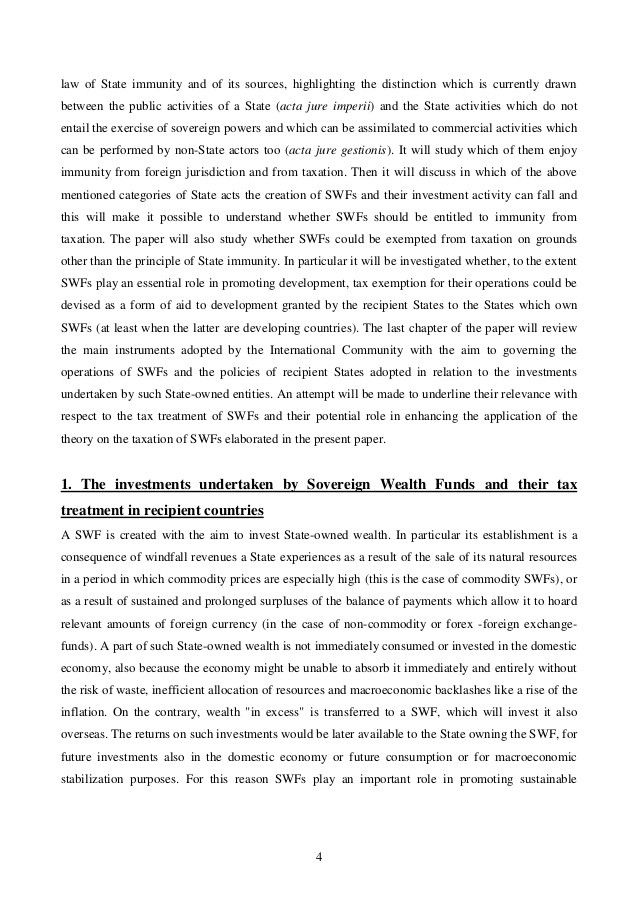Law at the End of the Day Sovereign Wealth Funds and Public Power The Case of Norway Part II
Post on: 10 Апрель, 2015 No Comment

Saturday, April 25, 2009
Sovereign Wealth Funds and Public Power: The Case of Norway Part II (Concepts and Regulatory Framework)
This is the second of a series of five (5) essays in which the nature and character of sovereign wealth funds are considered. Specifically the essays explore whether a sovereign wealth find can form itself to the ideals expressed in emerging regulatory regimes, like the Santiago Principles, one based on the idea that states may be treated like private entities with respect to their enterprises, formally sovereign but functionally private, as long as they conform to a set of behavior expectations which are said to distinguish sovereign from private behavior. The focus of that study is the socially responsible SWF, using as its model the Norwegian SWF, proffered by many as the model an an ideal form of sovereign wealth fund.
Part I provides an introduction to the issues to be considered and a framework for analysis. Part II explores the conceptual and regulatory framework currently arising for the transnational regulation of SWF grounded in the idea of a critical distinction between public actors and private action for constructing a system of SWF regulation. Part III focuses on the Norwegian Funds themselves: history, legal structure, and investment principles. It looks particularly at the role of the Ethics Council in SWF investment decisions. Part IV examines the Norwegian Funds in action. It explores the nature of the Norwegian SWF’s engagement with corporate social responsibility through its investments, as well as its engagement with two political situations: the Israel-Palestine conflict, and the political situation in Myanmar. Lastly it examines the use of the Norwegian Fund for purposes of promoting development and its application to issues of Norwegian macroeconomic policy in the face of the economic crisis of 2008, especially with respect to investment in India. Part V looks to the regulatory implications of the relationship between the idealized framework within which regulation is constructed and the reality of the operation of the Norwegian SWF. In particular, the following are examined: (1) The role of investment and the utility of the idealized private investor model; (2) the importance of approaches in conceptualization of regulatory options; and (3) participation versus regulation as an alternative to the Public/private model.
Sovereign Wealth Funds as Regulatory Chameleons: The Norwegian Sovereign Wealth Funds and Public Global Governance Through Private Global Investment

Larry Cata Backer*
Abstract: The character of global regulation has changed dramatically over the last decade. Today, multinational corporations sometimes assert substantial regulatory power across borders, and states sometimes enter markets as participants rather than as regulators especially when they engage in economic activity outside their borders through sovereign wealth funds ( SWFs ). In both cases the current transnational ordering has settled on voluntary principles based approaches to regulation. SWFs are controlled by states but seek to participate in private markets in the same way as private investment vehicles. But the difficulty has been the need to overcome the inherent sovereign character of state investment, central to the definition of SWFs. SWFs thus proceed from definition to conundrum. If SWFs are grounded in the reality of their formal connection to states, and if states are deemed sovereign in their actions, then it might be reasonable to assume that such funds could not be treated like private investment funds. To bridge that gap, it was necessary to find a way to disconnect SWFs from the state and sovereign activity, and to model private activity in a way that made it possible to construct a set of behavior principles that might produce an equivalence between SWFs and private investment vehicles. The first was accomplished by creating a functional distinction between state and SWF. a distinction unnecessary for traditional sovereign investment. The second was grounded in the presumption that there is a way of distilling the essence of private investment behaviors sufficiently precisely to distinguish those behaviors from sovereign conduct. Both are nicely captured in the Santiago Principles. Both are problematic as either as concept or in application. This paper looks closely at one example of this rising phenomenonthe socially responsible sovereign wealth fund. It focuses on a close review of one of the most influential funds, the Norwegian Government Pension FundGlobal ( Statens pensjonsfond — Utland ). It is among the largest and most influential SWF in the world, and the largest in Europe. The Norwegian SWF provides a particularly useful case study of the issues that are now at the center of reconceptualizations of the relationships between state and corporation, between economic and political regulation,between national and transnational legal frameworks, and between public and private legal regimes. The paper first describes conceptual and regulatory frameworks on which current policy discussions of sovereign wealth funds are undertaken. It then turns to the Norwegian funds, focusing on the history of the Norwegian fund, its legal structure and the development of its investment principles. It then looks to the way those principles were used in two distinct areasthe creation of incentives to produce changes in the behavior and culture of corporations and the response to the global financial crisis of 2008. The Norwegian SWF suggests that the rising model of SWF governance, grounded on an assumption that a state organization formally public but functionally private, acting like an idealized private investor does not work either for private investors who seek to use investment for political ends or state investment entities that purport to refrain from that sort of activity.














